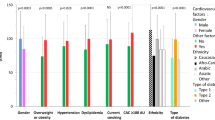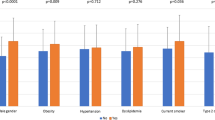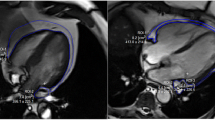Abstract
Purpose
To examine the association of epicardial and pericardial fat volume (EFV, PFV) with cardiovascular risk factors and kidney function in Native Americans of southwestern heritage with youth and early adult onset type 2 diabetes mellitus (T2DM) versus healthy controls.
Methods
Using computed tomography, we quantified EFV and PFV in 149 Native Americans (92 women, 57 men), 95 of which had T2DM (38 diagnosed prior to age 20 years). Duration of T2DM, mean carotid arterial mass (AM), coronary artery calcification (CAC), IL-6, and estimated glomerular filtration rate eGFRcr(CKD-EPI) were measured.
Results
EFV and PFV were associated with BMI (r = 0.37, p < 0.0001; r = 0.26, p = 0.001) and did not differ between onset age-groups and controls (p > 0.05). EFV was associated with AM only in controls (r = 0.51, p < 0.0001). After adjustment for BMI, T2DM duration, HbA1C, age, and sex, EFV was a predictor of CAC and IL-6 concentrations in early adult onset T2DM (β = 0.05 ± 0.02 cm3, p = 0.03; β = 0.05 ± 0.01 pg/ml/cm3, p = 0.002). EFV and PFV were independent predictors of reduced eGFRcr(CKD-EPI) in the youth onset T2DM group (β = −0.3 ± 0.08 ml/min/cm3, p = 0.001; β = −0.25 ± 0.05 ml/min/cm3, p < 0.0001).
Conclusions
Epicardial fat volume may be a risk factor for heart disease in individuals with early adult onset T2DM and a predictor of decreased kidney function in individuals with youth onset T2DM.



Similar content being viewed by others
References
Iacobellis G (2014) Epicardial adipose tissue in endocrine and metabolic diseases. Endocrine 46(1):8–15
Iozzo P (2011) Myocardial, Perivascular, and Epicardial Fat. Diabetes Care 34(Supplement 2):S371–S379
Mazurek T, Zhang L, Zalewski A, Mannion JD, Diehl JT, Arafat H et al (2003) Human epicardial adipose tissue is a source of inflammatory mediators. Circulation 108(20):2460–2466
Konishi M, Sugiyama S, Sugamura K, Nozaki T, Ohba K, Matsubara J et al (2010) Association of pericardial fat accumulation rather than abdominal obesity with coronary atherosclerotic plaque formation in patients with suspected coronary artery disease. Atherosclerosis 209(2):573–578
Bos D, Shahzad R, van Walsum T, van Vliet LJ, Franco OH, Hofman A et al (2015) Epicardial fat volume is related to atherosclerotic calcification in multiple vessel beds. Eur Heart J Cardiovasc Imaging 16:1264–1269
Pezeshkian M, Mahtabipour M-R (2013) Epicardial and subcutaneous adipose tissue Fatty acids profiles in diabetic and non-diabetic patients candidate for coronary artery bypass graft. BioImpacts 3(2):83–89
Tadros TM, Massaro JM, Rosito GA, Hoffmann U, Vasan RS, Larson MG et al (2010) Pericardial fat volume correlates with inflammatory markers: the framingham heart study. Obesity 18(5):1039–1045
Rosito GA, Massaro JM, Hoffmann U, Ruberg FL, Mahabadi AA, Vasan RS et al (2008) Pericardial fat, visceral abdominal fat, cardiovascular disease risk factors, and vascular calcification in a community-based sample: the framingham heart study. Circulation 117(5):605–613
Konishi M, Sugiyama S, Sato Y, Oshima S, Sugamura K, Nozaki T et al (2010) Pericardial fat inflammation correlates with coronary artery disease. Atherosclerosis 213(2):649–655
Hirata Y, Kurobe H, Akaike M, Chikugo F, Hori T, Bando Y et al (2011) Enhanced inflammation in epicardial fat in patients with coronary artery disease. Int Heart J 52(3):139–142
Saran R, Robinson B, Abbott KC, Agodoa LY, Albertus P, Ayanian J et al (2017) US renal data system 2016 annual data report: epidemiology of kidney disease in the US. Am J Kidney Dis 69(3 Suppl 1):A7–A8. https://doi.org/10.1053/j.ajkd.2016.12.004
Foley RN, Murray AM, Li S, Herzog CA, McBean AM, Eggers PW et al (2005) Chronic kidney disease and the risk for cardiovascular disease, renal replacement, and death in the United States medicare population, 1998 to 1999. J Am Soc Nephrol JASN 16(2):489–495
Kerr JD, Holden RM, Morton AR, Nolan RL, Hopman WM, Pruss CM et al (2013) Associations of epicardial fat with coronary calcification, insulin resistance, inflammation, and fibroblast growth factor-23 in stages 3–5 chronic kidney disease. BMC Nephrol 14:26
Cordeiro AC, Amparo FC, Oliveira MAC, Amodeo C, Smanio P, Pinto IMF et al (2015) Epicardial fat accumulation, cardiometabolic profile and cardiovascular events in patients with stages 3–5 chronic kidney disease. J Intern Med 278(1):77–87
Altun B, Tasolar H, Eren N, Binnetoğlu E, Altun M, Temiz A et al (2014) Epicardial adipose tissue thickness in hemodialysis patients. Echocardiography 31(8):941–946
Atakan A, Macunluoglu B, Kaya Y, Ari E, Demir H, Asicioglu E et al (2014) Epicardial fat thickness is associated with impaired coronary flow reserve in hemodialysis patients. Hemodial Int Int Symp Home Hemodial 18(1):62–69
Krakoff J, Lindsay RS, Looker HC, Nelson RG, Hanson RL, Knowler WC (2003) Incidence of retinopathy and nephropathy in youth-onset compared with adult-onset type 2 diabetes. Diabetes Care 26(1):76–81
Dabelea D, Hanson RL, Bennett PH, Roumain J, Knowler WC, Pettitt DJ (1998) Increasing prevalence of type II diabetes in American Indian children. Diabetologia 41(8):904–910
Nelson RG, Newman JM, Knowler WC, Sievers ML, Kunzelman CL, Pettitt DJ et al (1988) Incidence of end-stage renal disease in type 2 (non-insulin-dependent) diabetes mellitus in Pima Indians. Diabetologia 31(10):730–736
Pavkov ME, Bennett PH, Knowler WC, Krakoff J, Sievers ML, Nelson RG (2006) EFfect of youth-onset type 2 diabetes mellitus on incidence of end-stage renal disease and mortality in young and middle-aged pima indians. JAMA 296(4):421–426
Lillioja S, Mott DM, Spraul M, Ferraro R, Foley JE, Ravussin E et al (1993) Insulin resistance and insulin secretory dysfunction as precursors of non-insulin-dependent diabetes mellitus: prospective studies of pima Indians. N Engl J Med 329(27):1988–1992
Association AD (2005) Diagnosis and classification of diabetes mellitus. Diabetes Care 28(suppl 1):s37–s42
Safar ME, Boudier HS (2005) Vascular development, pulse pressure, and the mechanisms of hypertension. Hypertension 46(1):205–209
Agatston AS, Janowitz WR, Hildner FJ, Zusmer NR, Viamonte JM, Detrano R (1990) Quantification of coronary artery calcium using ultrafast computed tomography. J Am Coll Cardiol 15(4):827–832
Chasson AL, Grady HJ, Stanley MA (1960) Determination of creatinine by means of automatic chemical analysis. Tech Bull Regist Med Technol 30:207–212
Levey AS, Stevens LA, Schmid CH, Zhang YL, Castro AF, Feldman HI et al (2009) A new equation to estimate glomerular filtration rate. Ann Intern Med 150(9):604–612
Ho E, Shimada Y (1978) Formation of the epicardium studied with the scanning electron microscope. Dev Biol 66(2):579–585
Weissberg PL, Bennett MR (1999) Atherosclerosis—an inflammatory disease. N Engl J Med 340(24):1928–1929
Sacks HS, Fain JN (2007) Human epicardial adipose tissue: a review. Am Heart J 153(6):907–917
Yudkin JS, Eringa E, Stehouwer CDA (2005) “Vasocrine” signalling from perivascular fat: a mechanism linking insulin resistance to vascular disease. Lancet Lond Engl 365(9473):1817–1820
Henrichot E, Juge-Aubry CE, Pernin A, Pache J-C, Velebit V, Dayer J-M et al (2005) Production of chemokines by perivascular adipose tissue: a role in the pathogenesis of atherosclerosis? Arterioscler Thromb Vasc Biol 25(12):2594–2599
Barandier C, Montani J-P, Yang Z (2005) Mature adipocytes and perivascular adipose tissue stimulate vascular smooth muscle cell proliferation: effects of aging and obesity. Am J Physiol Heart Circ Physiol 289(5):H1807–H1813
Iacobellis G, Bianco AC (2011) Epicardial adipose tissue: emerging physiological, pathophysiological and clinical features. Trends Endocrinol Metab 22(11):450–457
Belcaro G, Nicolaides AN, Laurora G, Cesarone MR, De Sanctis M, Incandela L et al (1996) Ultrasound morphology classification of the arterial wall and cardiovascular events in a 6-year follow-up study. Arterioscler Thromb Vasc Biol 16(7):851–856
Hartman J, Frishman WH (2014) Inflammation and atherosclerosis: a review of the role of interleukin-6 in the development of atherosclerosis and the potential for targeted drug therapy. Cardiol Rev 22(3):147–151
Interleukin-6 receptor mendelian randomisation analysis (IL6R MR) consortium, Swerdlow DI, Holmes MV, Kuchenbaecker KB, Engmann JEL, Shah T et al (2012) The interleukin-6 receptor as a target for prevention of coronary heart disease: a mendelian randomisation analysis. Lancet Lond Engl 379(9822):1214–1224
Knowler WC, Pettitt DJ, Saad MF, Bennett PH (1990) Diabetes mellitus in the pima Indians: incidence, risk factors and pathogenesis. Diabetes Metab Rev 6(1):1–27
Pavkov ME, Sievers ML, Knowler WC, Bennett PH, Nelson RG (2004) An explanation for the increase in heart disease mortality rates in diabetic Pima Indians: effect of renal replacement therapy. Diabetes Care 27(5):1132–1136
Luk AOY, So W-Y, Ma RCW, Kong APS, Ozaki R, Ng VSW et al (2008) Metabolic syndrome predicts new onset of chronic kidney disease in 5829 patients with type 2 diabetes: a 5-year prospective analysis of the Hong Kong Diabetes Registry. Diabetes Care 31(12):2357–2361
Funding
This research was supported by the Intramural Research Program of the National Institutes of Health, National Institute of Diabetes and Digestive and Kidney Diseases.
Author information
Authors and Affiliations
Contributions
MR wrote the manuscript. MR and TC analyzed the data. MR, MST, TC, and JK designed the study. MR and TC quantified epicardial and pericardial adipose tissue. MR, TC, MST, and JK contributed to the interpretations of findings and commented on and edited the drafts. JK is the guarantor of this work and, as such, had full access to all the data in the study and takes responsibility for the integrity of the data and the accuracy of the data analysis.
Corresponding author
Ethics declarations
Conflict of interest
The authors declare no conflict of interest.
Ethical standards
All procedures performed in studies involving human participants were in accordance with the ethical standards of the institutional and/or national research committee and with the 1964 Helsinki declaration and its later amendments or comparable ethical standards.
Research involving human participants and/or animals
This article does not contain any studies with animals performed by any of the authors. This study was approved by the NIDDK Institutional Review Board.
Informed consent
All participants gave written and verbal informed consent for the studies.
Additional information
Publisher's Note
Springer Nature remains neutral with regard to jurisdictional claims in published maps and institutional affiliations.
Rights and permissions
About this article
Cite this article
Reinhardt, M., Cushman, T.R., Thearle, M.S. et al. Epicardial adipose tissue is a predictor of decreased kidney function and coronary artery calcification in youth- and early adult onset type 2 diabetes mellitus. J Endocrinol Invest 42, 979–986 (2019). https://doi.org/10.1007/s40618-019-1011-8
Received:
Accepted:
Published:
Issue Date:
DOI: https://doi.org/10.1007/s40618-019-1011-8




